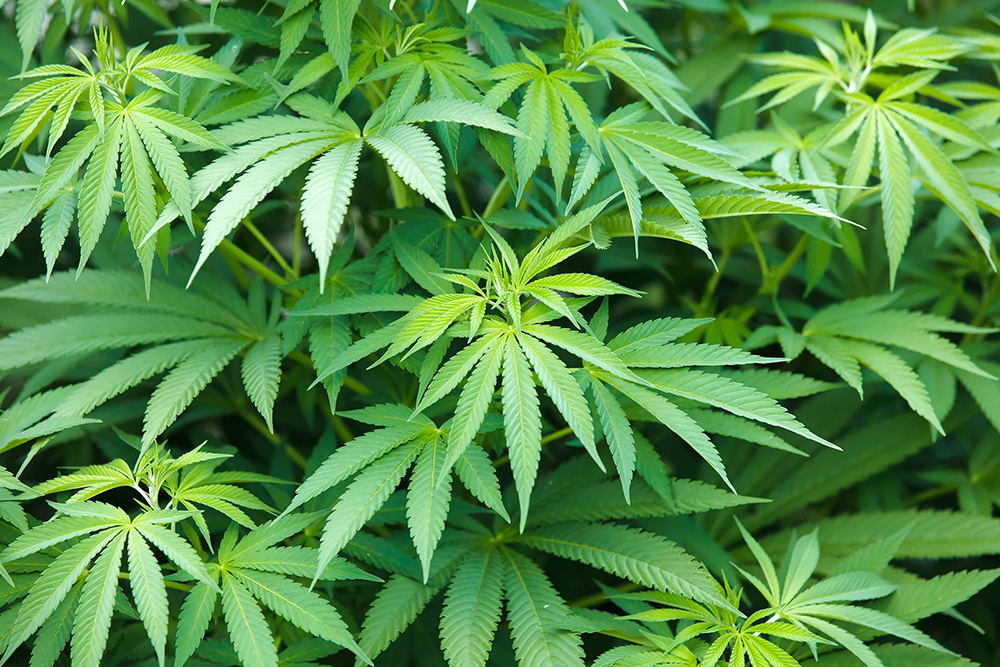Cannabis, also known as marijuana (among countless other names), is a psychoactive intoxicant that was banned in Canada from 1923 until medical cannabis became legal in 2001. The consumption and sale of recreational cannabis was legalized and regulated on 17 October 2018, after Parliament passed Bill C-45, the Cannabis Act. Legalization was supported by a majority of Canadians, despite concerns about the drug’s addictiveness and health effects, especially among young people.

Cannabis
Cannabis is a type of flowering plant that originated in Asia but is grown around the world. The plant has a wide variety of uses, including as a recreational hallucinogen or as a prescribed medicine. To produce a high, the plant’s leaves and flower buds can be dried and smoked (called marijuana, pot and weed, among countless other names), consumed as an oil (called hash oil), a resin (hash) or from concentrates (including shatter). In these forms, cannabis can also be vapourized to produce a vapour rather than smoke. Cannabis can also be added to foods and drinks.
People get a high from the chemical tetrahydrocannabinol (or THC), which is one the main organic compounds found in cannabis. Many people find THC to be a relaxing substance, while others find that it produces an anxious and/or paranoid feeling. THC also intensifies the experience of sight, taste, sound and smell.
Another organic compound found in cannabis is cannabidiol (or CBD), which does not produce a high. CBD is credited with treating several medical problems, including seizures, anxiety and inflammation.
When cultivated as hemp, fibres are extracted from the cannabis stem and used to make rope and fabrics, among many other applications.
History of Cannabis Prohibition in Canada
In 1923, “Cannabis Indica (Indian Hemp) or hasheesh” was added to Prime Minister William Lyon Mackenzie King’s Act to Prohibit the Improper Use of Opium and other Drugs. The new act combined several drug laws that had been introduced over the years. Cannabis joined opium, heroin and cocaine on the list of prohibited drugs when it was added to a late draft of the bill — it is unclear why it was added or by whom. The prohibition of cannabis was not discussed in Parliament and law makers had little knowledge of the drug. Few Canadians knew of, or used, cannabis and it was not mentioned in a popular series of articles published in Maclean's magazine in 1920 describing the evils of the drug trade.
Historian Catherine Carstairs suggests that the prohibition of cannabis was likely the result of its mention at international conferences, including the Hague Opium Conference (1911–12). Also, by 1922, cannabis had been prohibited in 10 American states. According to one government official, “It appears that Col. Sharman [chief of the narcotic division] returned from meetings of the League of Nations convinced that cannabis would soon fall under international control. In anticipation… he moved to have it added to the list of drugs controlled under Canadian law.”
Cannabis advocates have argued that its prohibition was influenced by the work of suffragist and judge Emily Murphy, the lead petitioner in the 1929 Persons Case. Murphy discussed cannabis in a short chapter of her book The Black Candle (1922), titled “Marahuana — a new menace.” In that chapter, she claimed that smokers “become raving maniacs” and “are liable to kill or indulge in any sort of violence.” According to Carstairs, however, there is no clear link between the publication of The Black Candle and the inclusion of cannabis in the 1923 drug bill. The book was focused primarily on opium, she argues, and was not a commercial success. It also said little about cannabis. As Carstairs explained to the CBC, “ There were insinuations in the records that the bureaucrats at the division of narcotic control did not think very highly of Emily Murphy… [nor] consider her a particularly accurate or valuable source.”
Cannabis became illegal at a time when few Canadians had heard of the substance. Police did not report seizing cannabis until 1932, and the first possession offences did not occur until 1937. Between 1923 and 1965, only 270 possession offences were reported (it is not clear whether these were charges or convictions).
As cannabis grew in popularity in the late 1960s, the federal government formed a Royal Commission, known as the Le Dain Commission, to study its use. The commission’s 1972 report argued that cannabis prohibition was costly to both individuals and the state. At the time, the maximum penalty for possessing small amounts of cannabis was six months in prison and a $1,000 fine for a first offence. The report recommended that cannabis possession be decriminalized.
Government largely overlooked cannabis decriminalization, or regulation, for decades.
Critics of the prohibition — including cannabis growers, sellers and activists — campaigned for decades to have the government reform the country’s cannabis laws. Marc Emery, a Vancouver-based activist and founder of Cannabis Culture magazine and retail stores, was at the forefront of this effort for many years. There was also increasing support for legalization among Canadians. In the years leading to legalization, surveys showed that between 40 and 70 per cent of Canadians wanted recreational cannabis use made legal. However, most people surveyed also wanted government controls over how the drug is sold or dispensed. A majority also feared that legalization would likely increase cannabis use among people under the age of 21.
From Prohibition to Legalization
In 2000, the Ontario Court of Appeal decided that cannabis prohibition was unconstitutional because it did not make an exemption for medical use. Health Canada responded to this ruling the following year, when it regulated access to cannabis for licensed patients, who were permitted to grow their own cannabis or access it from licensed producers.
After medical regulation, the Liberal governments of Jean Chrétien and Paul Martin introduced legislation to decriminalize cannabis in 2003 and 2004 — both bills failed.
The approach to cannabis changed considerably under the Conservative government of Stephen Harper, which imposed mandatory sentences on cannabis dealers and minimum sentences for illegal producers. This shift in government approach led to increased arrests for simple possession in cities across the country.
In 2013, new federal regulations allowed for the production and distribution of medical cannabis, creating a licensed, commercial industry. In 2015, the Supreme Court of Canada decided that it was unconstitutional to restrict medical patients to smoking dried cannabis. The ruling made it legal for licensed producers to make cannabis oils, and other products made from cannabis extracts. It also made it legal to add cannabis to foods and drinks.
In 2015, Prime Minister Justin Trudeau’s Liberal government announced that it intended to legalize cannabis use and regulate its sale. In June 2016, it created the Task Force on Marijuana Regulation and Legalization led by Anne McLellan, a former health and justice minister. The task force held public consultations and spoke to provincial, territorial, municipal and Indigenous governments in Canada.
The government stated that cannabis prohibition did not work, that it did not stop young people from using it, thereby putting their health at risk, and that it left many Canadians with criminal records. The Liberal Party had said previously that criminal prosecutions around cannabis are expensive and drive money into criminal enterprises.
The government ruled out simply decriminalizing marijuana. That approach would have meant keeping cannabis as an illegal substance while replacing criminal sanctions with fines or other lesser penalties. It also ruled out decriminalizing cannabis before legalization, saying that would “give the green light” to illegal dealers to sell it openly.
Until 17 October 2018, cannabis was listed as a controlled substance in Schedule II of the Controlled Drugs and Substances Act. As such, people found in possession of up to 30 grams of cannabis (without a medical exemption) faced a fine of up to $1,000 and as many as six months in jail. There were more severe criminal penalties for trafficking and producing cannabis. Half (53 per cent) of all drug offences in 2017 were for the possession and/or trafficking, production and distribution of cannabis. In 2017, nearly 48,000 such offences were reported in Canada.
Before legalization, estimates of the value of the cannabis trade in Canada varied widely. One of the highest estimates comes from the Task Force on Marijuana Regulation and Legalization, which said in 2016 that the illegal trade was worth $7 billion in annual income to organized crime.
Cannabis Prohibition and Race
In February 2016, former Toronto Police chief (2005–15) and Liberal MP Bill Blair explained part of the reason why the government wanted to legalize cannabis: “One of the great injustices in this country is the disparity and the disproportionality of the enforcement of these laws and the impact it has on minority communities, Aboriginal communities and those in our most vulnerable neighbourhoods.”
While police do not uniformly track data on race, several studies have suggested that Indigenous, Black and Asian Canadians were overrepresented in prisons for drug charges and arrests. In 2017, the Toronto Star examined 10 years (2003–13) of Toronto Police data and found that Black people with no criminal record were three times as likely to be arrested for cannabis possession than White people with no prior charges. (Rates of cannabis use were about the same for Black and White Canadians.)
When cannabis was legalized in 2018, legislation did not provide amnesty for earlier cannabis possession or trafficking charges. However, on the day cannabis became legal, the Canadian government announced that it would introduce new legislation allowing people charged in the past with “simple possession” to apply for a pardon with no fee or waiting period. Pardons are normally expensive and can take years to process. Possessing a criminal record makes it difficult to find work and travel abroad. A pardon removes an offence from an individual’s criminal record with the Canadian Police Information Centre. The government did not, however, offer to expunge former cannabis offences, which would completely remove a past conviction from someone’s record.
Cannabis Legalization in Canada
In April 2017, the government introduced Bill C-45, the Cannabis Act, aimed at legalizing and regulating the production and sale of cannabis. The Act received royal assent on 21 June 2018 and came into force on 17 October 2018. The new law made Canada the second country in the world after Uruguay to legalize cannabis. By 2018, recreational cannabis was also legal for adults in nine US states and the District of Columbia, and 30 states had government-sanctioned medical cannabis programs.
The new law permits Canadians aged 18 and older to buy cannabis by mail or in provincially regulated retail stores. Under the law, adults are also allowed to grow up to four cannabis plants at home, and to have up to 30 grams of dried cannabis (or the equivalent in non-dried form) in their possession in public. The Cannabis Act created new criminal offences for the sale of cannabis to youth — with penalties of up to 14 years in prison. It also prohibits “illicit” cannabis of unlicensed producers, sellers and distributors.
The sale of edible forms of cannabis, such as baked goods or drinks, and cannabis concentrates was not immediately allowed under the Act. Regulations on the sale of edibles, extracts and topicals came into force on 17 October 2019. The earliest they will be sold is mid-December, however. Products that mix cannabis with alcohol, tobacco or nicotine will be prohibited.
Government regulations for growing and selling cannabis include standards for labelling and packaging. Every package must be plain, without additional imagery besides brand name and logo. Packages must also include a standardized cannabis symbol, a health warning and THC concentration levels.
The government also established the tax rate for cannabis, to be split by the federal and provincial governments (see Taxation in Canada).
In April 2017, the government also introduced Bill C-46, which received royal assent on 21 June 2018. The bill amended the Criminal Code and permitted police to submit drivers to random roadside Breathalyzer tests for alcohol; administer roadside saliva tests to screen for drugs, including THC; and set THC blood limits for driving.
Medical Cannabis
Recreational cannabis laws did not change Canada’s medical cannabis system. Canadians can legally access cannabis under Health Canada regulations established in 2001. Cannabis has various therapeutic benefits, ranging from helping with nausea and vomiting during chemotherapy treatment, to the alleviation of chronic pain.
As of 2016, about 70,000 Canadians had registered with their health-care practitioner as medical-marijuana users. Card-carrying users can grow marijuana for their own medical use or order it from one of approximately 116 licensed producers and have the marijuana mailed to them for medicinal purposes.
Risks and Regulation
In 2018, the federal government introduced a regulatory system to control the sale and consumption of cannabis, establish product safety and quality requirements and deter black market trafficking. The system was based on existing alcohol and tobacco regulations, which are aimed at reducing or eliminating the use of tobacco among Canadians and promoting the responsible use of alcohol among adults. In both cases, government also works to keep young people from using the substances.
Government regulation restricts cannabis from high-risk users (for example under-age people) and high-risk situations (such as driving). It also sets a recommended minimum age for possession at 18 years — allowing provinces to raise that age — and includes offences for people who sell cannabis to youth under 18 years old.
Before legalization, the Canadian Medical Association (CMA), which represents the country’s doctors, urged the federal government to ban cannabis for people under 21, and to limit its use for people under 25. The CMA also wanted the government to slowly phase-in any legalized system, perhaps with pilot programs tested in certain regions of the country.
Adolescents have rapidly developing brains that can be harmed by regular cannabis use. Research presented by the Canadian Centre on Substance Abuse indicates that chronic use (especially if started in adolescence) is associated with problems in memory, thinking and paying attention. It could also increase the risk of psychosis, depression, anxiety, and lung cancer (if smoked).
Legislation therefore limits the marketing and advertising for cannabis and prohibits anything that might target youth specifically. Cannabis and its related products cannot be promoted in ways that evoke “glamour, recreation, excitement, vitality, risk or daring,” and cannot be endorsed by celebrities. Cannabis brands also cannot sponsor buildings, activities and events.
However, the Cannabis Act did not set maximum THC potency levels. Research shows that current THC levels, the psychoactive part of cannabis, are around 12 to 15 per cent — up from 3 per cent in the 1980s. Some cannabis-based products such as shatter can reach 80 to 90 per cent. A 2016 report by the US Surgeon General said the changing nature of cannabis, including its addictiveness due to the rapidly increasing potency of the modern product, poses a health risk to consumers.
Pardons for Past Convictions
There have been calls for the government, along with legalizing cannabis, to pardon or suspend the records of Canadians previously convicted of cannabis offences. These convictions hamper their ability to travel, apply for jobs and volunteer with charities. According to one study, as many as 500,000 Canadians may possess a criminal record for cannabis possession. The government did not provide general amnesty for past cannabis convictions, but says it is looking at options for “less serious” cases.
When Cannabis became legal on 17 October 2018, the government announced that it would introduce new legislation allowing people charged in the past with “simple possession” to apply for a pardon with no fee or waiting period. Pardons are normally expensive and can take years to process. A pardon removes an offence from an individual’s criminal record with the Canadian Police Information Centre. Only an expungement can completely remove a past conviction from someone’s record. The government did not offer to expunge former cannabis offences.
International Drug Treaties and Conventions
Canada has signed three United Nations conventions on narcotic drug use: the 1961 Single Convention on Narcotic Drugs, the 1971 Convention on Psychotropic Substances, and the 1988 Convention Against Illicit Traffic In Narcotic Drugs and Psychotropic Substances.
Those conventions mean that Canada is obliged to criminalize the listed substances, which include cannabis for non-medical and non-scientific uses. Legalizing cannabis goes against the drug conventions — although the 1961 convention does allow signatory nations to apply for the removal of a drug from the banned list.
The UN International Control Board has named a handful of countries with legalized cannabis and declared them to be in violation of the treaties.
The Canadian government has said it will not withdraw from these conventions.

 Share on Facebook
Share on Facebook Share on X
Share on X Share by Email
Share by Email Share on Google Classroom
Share on Google Classroom

